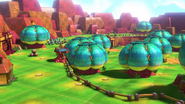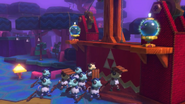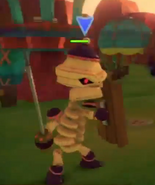This page explains in detail the interactions between the Nintendo Land series and the Zelda series.
Nintendo Land[]
November 18, 2012

Icon for The Legend of Zelda: Battle Quest.

Four Miis dressed as Link.
One of the 12 attractions in the game is based on the Zelda series, and is called The Legend of Zelda: Battle Quest. It's a Team attraction for up to 4 players and has Miis dressed as Link, with the player using the Wii U GamePad armed with bow and arrow, while the other players are armed with the Master Sword and Hylian Shield. While the tunics seem very generic versions of Link, the hat also has part of his hair, and it seems to be based on his Ocarina of Time incarnation. The Link armed with the bow is always in the green tunic, while player 2 wears a red tunic, player 3 a blue tunic and player 4 a yellow tunic. While in four player Zelda games the fourth Link have always been Purple, here it's changed to yellow for unknown reasons, but these colors might be based on the knights from Skyward Sword that wear tunics in these colors, with Pipit being yellow. Unlike in the original games, the different colors are also applied to the Master Sword's handle and to the background of the shield's design, therefore with only the blue Link's weapons corresponding to their original colors. In case of a single player game using the nunchuck, then the Mii will be dressed in the green tunic, but weild the blue sword and shield, to reflect Link's original appearance.

Nintendo Land OST - Battle Quest - Intro
Intro music for The Legend of Zelda: Battle Quest.
The gameplay has the Miis authomatically walking in Zelda-inspired levels and they have to defeat all enemies encountered up to the final boss of the level. All Miis share a lifebar of six hearts. The first player can point the bow by moving the Wii U GamePad, and shoots by moving the control stick, with the shot being chargeable like in Skyward Sword. Other players deliver slashes by swinging the WiiMote, and by holding it upwards they can charge the sword to perform a Spin Attack, based on how the Skyward Strike is performed in Skyward Sword.

The Triforce.
Like in Zelda games pots are found around the game that can be broken to get hearts, and defeated enemies sometimes drop Rupees. After defeating the boss of a level, the Triforce appears and after getting it the players are brought to the next level. Also the Triforce logo is found throughout most of the levels. The background music in menus and tutorial for levels is a remix of the title screen theme from The Legend of Zelda.
The levels are:
The Grasslands[]
Based on the overworld from most Zelda games, the enemies are ChuChus, that are based on their appearance and behaviour from The Wind Waker, and Moblins that are based on their appearance from the 2D Zelda games, but behaving like Bokoblins from Skyward Sword. Three Moblins armed with club and shield serve as the boss of the level. The background music is a remix of the overworld theme from The Legend of Zelda.
The Lost Woods[]
Based on generic forest levels from the Zelda series, with "Lost Woods" being a recurring location in the games. In some points of the level there's a mechanical tree with a mustached face, resembling the Deku Tree from Ocarina of Time. The enemies are Chuchus and Moblins, while the end boss is a Big Moblin, similar to the one found in the Lost Woods in Ocarina of Time. The background music is a remix of the Lost Woods theme (Saria's Song) from Ocarina of Time.
Grassland Temple[]
Based on generic temples from Zelda games, it starts in an area similar to The Grasslands also featuring the same background music, and then the Miis enter the titular temple. Enemies outside the temple are Moblins and Kargaroks from Twilight Princess, while inside it there are Moblins and Tektites, that sport an original look and behaviour. The end boss is a Big Moblin along with two shield-weilding Moblins. The background music inside the tempe is an original ambient music reminiscent of temple themes from throughout the Zelda series.
Road to the Goron Mines[]
Named after the Goron Mines dungeon from Twilight Princess, it starts in an area reusing the same elements as The Lost Woods, also featuring the same background music, and then the Miis enter a cave which then leads to the side of a mountain. At the end of the level there are two large mechanized Goron heads above the arena for the boss fight. Enemies are mostly Moblins with some Kargaroks in the mountain section, a Big Moblin fought as a miniboss before entering the cave, a Skulltula fought before exiting the cave and then two Skulltulas as the end bosses. The background music in the cave/mountain area is a remix of the Dark World theme from A Link to the Past.
The Forest Temple Hunt[]
Named after the recurring Forest-themed temples from the Zelda series, it starts in a foggy area reusing the same elements as The Lost Woods and also featuring the same background music, and then the Miis enter the titular temple. The music inside the temple is the same as in the Grassland Temple. Enemies are Moblins throughout the level, with two Skulltulas before entering the temple and some ChuChus and a Big Moblin inside. The final boss is a Wizzrobe, based mostly on its appearance from The Wind Waker, that attacks by shooting Keese, the bats from the Zelda series, and then a ball that must be hit to make it bounce back at the enemy some times, a recurring type of boss fight in the Zelda series (referred to as "Dead Man's Volley" in Phantom Hourglass).
Death Mountain Climb[]
Named after one of the most recurring locations in the Zelda series, it features the same alements as the mountain section of Road to the Goron Mines. Middleway through the level the Miis also enter a very dark cave, while the boss is fought in an arena based on Death Mountain's crater. Enemies are Moblins, Tektites and Kargaroks, with an armored Big Moblin and two Moblins serving as the end boss. The background music is a remix of the Gerudo Valley theme from Ocarina of Time.
Gerudo Fortress Trail[]
Named after the location from Ocarina of Time, it starts in an area identical to the starting one in Grassland Temple, also with the same backround music, then the Miis enter a cave similar to the one in Road to the Goron Mines, pass through a firy cave similar to the final area of Death Mountain Climb, and finally exit the cave to a mountain area where the boss is fought. Music in the cave/montain areas is the same as in the first area of Death Mountain Climb. Enemies in the first area are Moblins, Kargaroks and Stalfos, the skeletal enemies from Zelda games, then Tektites and Keese inside the first part of the cave, Moblins in the firy part of the cave, then a Wizzrobe as the end boss.
Ganon's Castle Approach[]
A level starting in a mountain area with a firy cave, and then the Miis enter a temple similar to the Grassland Temple, but with a different arena at the end. The background music is the remake of the Gerudo theme in the first area, and then the temple music featured in previous levels. Enemies are Moblins and Stalfos, plus a Wizzdrobe as a miniboss at the end of the first area, two Skulltulas, some Keese and Tektites inside the temple. Two Big Moblins, one of them armored, and three Moblins with club and shield serve as the end boss.
Raid on Ganon's Castle[]
The last level of the game, based on the main villain's castle from Ocarina of Time, it starts outside the castle, where the archer is forced to walk on the castle walls, while the other Miis enter it through the gates. The Miis reunite in the first room of the castle, which is similar to the Grassland Temple, and then move on to the second area of the level, which is a dark cave like the one in Death Mountain Climb. The third area is set on top of the castle, The background music is the same as in previous temple levels. Enemies are Moblins and Tektites throughout the level, plus Chuchus outside the caslte gates, Kargaroks on the walls and in the castle top area, a Wizzrobe serving as a miniboss at the end of the first area, Keese in the dark cave, and two Big Moblins in the castle top area. The end boss is Ganon, the recurring villain from the series, based mostly on his appearance from the 2D Zelda games, but armed with daggers like in Ocarina of Time.
Extra quests[]

Armored Ganon.
Five extra levels reusing the same themes and elements as the regular ones, but with increased difficulty. These are: The Sacred Grove, named after a location from Twilight Princess, Journey to the Fire Temple, named after the recurring fire-themed temples from the Zelda series, Death Mountain Path, Battle of Hyrule Field and Ganon's Last Stand. Ganon is fought again at the end of Journey to the Fire Temple, and then at the end of Ganon's Last Stand he's fought wearing an armour.
License[]
Copyrights for both series are held by Nintendo.
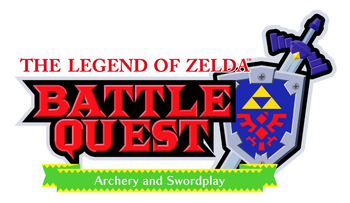
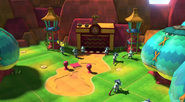

![Nintendo Land OST - Battle Quest - Quest (22 KB) Background music for the level.]]](https://static.wikia.nocookie.net/fictionalcrossover/images/6/6c/Nintendo_Land_OST_-_Battle_Quest_-_Quest/revision/latest/scale-to-width-down/185?cb=20131028230056)



